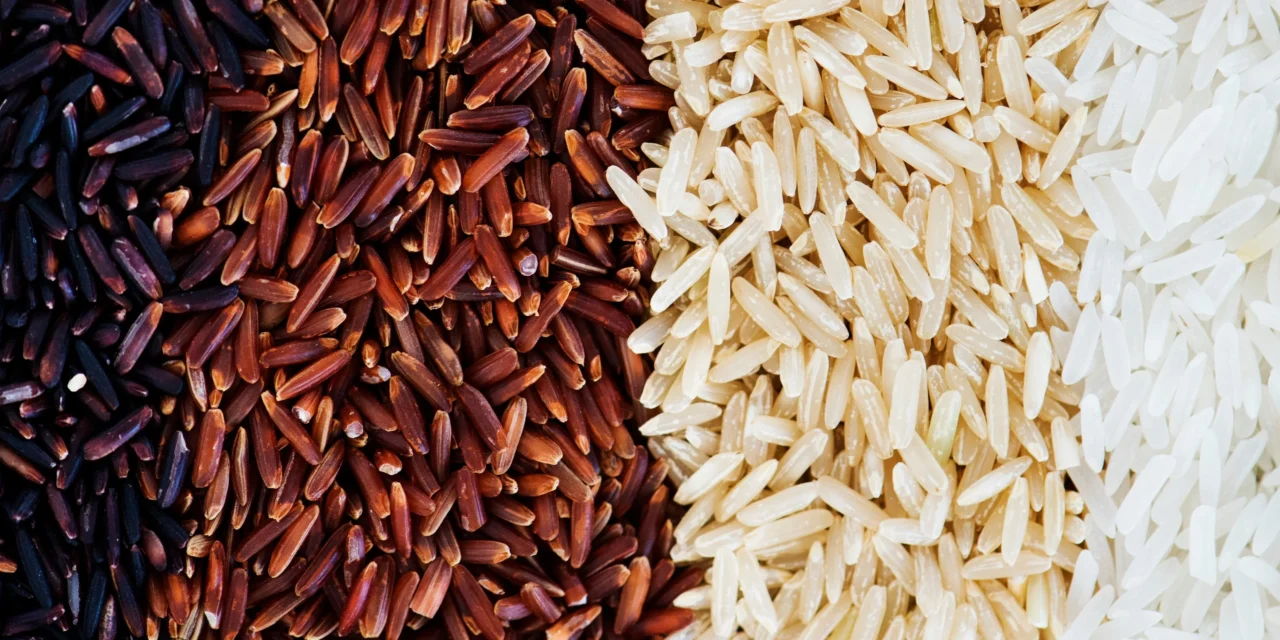The differences between white, brown, and red rice primarily lie in their processing methods, nutritional content, and health benefits. Here’s a detailed comparison:
1. Processing
White Rice
- Processing:
- Undergoes extensive milling and polishing, removing the outer husk, bran layer, and germ.
- Results in a smooth, white grain with a longer shelf life.
- Impact on Nutrients:
- Loses most of its fiber, vitamins, and minerals during processing.
- Sometimes enriched with synthetic nutrients like iron and folic acid to compensate.
Brown Rice
- Processing:
- Only the outer husk is removed, retaining the bran layer and germ.
- Less processed compared to white rice.
- Impact on Nutrients:
- Retains fiber, essential fatty acids, and nutrients like magnesium, B vitamins, and antioxidants.
Red Rice
- Processing:
- Typically unpolished or partially polished, retaining most of its bran layer.
- The red or reddish-brown color comes from anthocyanins in the bran.
- Impact on Nutrients:
- Maintains high levels of antioxidants, fiber, and micronutrients.
2 Health Benefits
White Rice
- Pros:
- Easy to digest, making it suitable for people with sensitive stomachs or recovering from illnesses.
- Has a softer texture and shorter cooking time.
- Cons:
- Lacks fiber, leading to rapid blood sugar spikes (high glycemic index).
- Lower in vitamins and minerals compared to brown and red rice.
- Best For:
- Athletes needing quick energy.
- Dishes requiring a delicate, fluffy texture (e.g., biryani, sushi).
Brown Rice
- Pros:
- Rich in fiber, promoting better digestion and a lower glycemic index.
- Contains essential minerals like magnesium, selenium, and phosphorus.
- Helps in weight management due to its satiating properties.
- Cons:
- Longer cooking time and a chewier texture.
- May contain phytic acid, which can interfere with mineral absorption.
- Best For:
- People managing diabetes or heart health.
- Those seeking whole grains for improved digestion and overall health.
Red Rice
- Pros:
- Contains anthocyanins, which are powerful antioxidants that help reduce inflammation and fight free radicals.
- Rich in iron, zinc, and other micronutrients, supporting blood health and immunity.
- High fiber content aids in digestion and weight management.
- Cons:
- Stronger, nutty flavor and firmer texture that may not suit all palates.
- Slightly longer cooking time.
- Best For:
- People looking for nutrient-dense whole grains with antioxidant benefits.
- Those managing cholesterol and cardiovascular health.
3. Glycemic Index (GI)
- White Rice: High GI (70–89), causing rapid blood sugar spikes.
- Brown Rice: Moderate GI (50–55), leading to slower digestion and steadier blood sugar levels.
- Red Rice: Low to Moderate GI (45–55), making it ideal for diabetics and weight management.
4. Flavor and Texture
- White Rice: Mild flavor, soft texture, ideal for versatile cooking.
- Brown Rice: Nutty flavor, slightly chewy texture, suitable for hearty dishes.
- Red Rice: Robust nutty flavor, firmer texture, pairs well with rich or spiced dishes.
5. Shelf Life
- White Rice: Longer shelf life due to the removal of the bran and germ, which contain oils that can spoil.
- Brown Rice: Shorter shelf life (6–12 months) due to the oil content in the bran layer.
- Red Rice: Similar to brown rice, with a moderate shelf life depending on processing.
6. Environmental Considerations
- White Rice: Requires more processing, increasing energy and resource use.
- Brown Rice: Less processed, making it a more sustainable choice.
- Red Rice: Often cultivated traditionally and organically, supporting biodiversity and sustainable farming.
Conclusion
- White Rice: Best for quick energy, delicate dishes, or those with specific dietary needs.
- Brown Rice: Ideal for general health improvement, weight management, and reducing the risk of chronic diseases.
- Red Rice: A nutrient powerhouse offering antioxidant benefits and best for those seeking functional health benefits alongside whole-grain advantages.
Choosing between these types depends on individual health goals, dietary preferences, and culinary needs.
Hashtags
#RiceLovers #RiceRecipes #RiceDishes #RiceBowl #RiceBowlRecipes #RiceBowlIdeas #RiceBowlInspiration #RiceBowlGoals #RiceBowlAddict #RiceBowlObsessed #RiceBowlLove #RiceBowlLife #RiceBowlHeaven #RiceBowlCravings #RiceBowlPerfection #RiceBowlGoals #RiceBowlInspo #RiceBowlObsession #RiceBowlAddiction #RiceBowlGoals









